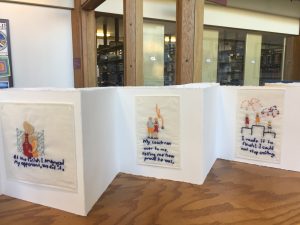
Embroidery, international travel, storytelling, and history all share a common thread for Concordia printmaking professor Heidi Goldberg.
On Jan. 12, two art exhibits created by students enrolled in courses taught by Goldberg were opened to the public. One exhibit is titled “Craft and Identity—Summer School in Norway: Learning Weaving Traditions of Western Norway” and is on display at the Prairie Fiber Arts Center in Moorhead. It features woven works created by students during their time in Norway last summer. The other, titled “Embroidered Narrative in Book Form” is on display in the Carl B. Ylvisaker Library on Concordia’s campus. The books were created for Goldberg’s Credo inquiry seminar.
Last summer, from May 9 to June 7, a group of four Concordia students traveled to Norway with Goldberg to learn how crafting is connected with identity and culture. Over the course of the trip, students learned about art, history, and culture through exploring and experiencing new places.
Goldberg’s interest in Scandinavian crafts began when she was a young girl when her mother taught her to knit. Weaving is also a significant part of the tradition, where items such as cloaks and bedspreads are created. In Norway, Goldberg was able to share that interest with others.
“We visited museums and galleries to look at old work and new work so we could observe correlations, differences, and the evolution of craft and art. It’s fascinating to see what contemporary artists are making and how some of their works are related to traditions,” she said.
Students Alexis Anderson, Kristina Brunson, Rachel Johnson, and Alli Pahl joined Goldberg on the trip.
Senior graphic design major Kristina Brunson loves to travel and jumped at the opportunity to go to Norway with Goldberg. While the scenery was incredible, the knowledge she gained added even more importance to the whole experience.
“I think the most important thing I learned is that we look at things and we don’t always see what it takes, the energy, that was put into something. I definitely came out with more respect for some of those things,” she said.
But the students were not the only ones to gain something from the trip.
“It’s really gratifying for me as a teacher to watch my students learn to do something quite difficult.They did a fantastic job of embracing work that was totally new to them and everyone made a beautiful piece,” Goldberg said.
Goldberg had the opportunity to continue teaching about craft and tradition in an inquiry seminar course in the fall called “We Are What We Make: Tradition and Identity in Daily Life.” Students in this class used embroidery as a medium to tell their stories. The illustrations and words are embroidered onto cloth pages in accordion, scroll, or traditional book format. One of Goldberg’s hopes for the class was to change the way students think about embroidery.
“Most of us have preconceptions of what the medium is, often associating it with flowery, sentimental, granny craft. Many artists today are using embroidery in unconventional and exciting ways. There is the movement of craftivism in which artists articulate ideas centered in important messages related to feminism and social change, and there are many artists pushing technical and aesthetic boundaries with the medium,” Goldberg said.
One of Goldberg’s inquiry students, first-year biology major Linka Wintersteen, enjoyed the use of embroidery even though she did not have this skill before the course.
“Embroidery offers a unique control to art-making that forms such as painting, drawing, or sculpture don’t allow. With embroidery, detail is completely in your hands,” Wintersteen said.
Over the course of the semester, students learned about crafting traditions throughout history and cultures and had the opportunity to experience the same crafts that they had discussed. Other components of the course included poetry and guest speakers.
“Traditions of making art, in any form, are what build the identity of a people. By partaking in the traditional crafts of our ancestors and of cultures unrelated to us, we gain a better connection to the people who came before us,” Wintersteen said.
Goldberg agrees with the importance of tradition and craft.
“Not only is the process of making things satisfying, it invites reflections and interpretations on life that have depth of meaning and individual expression. Tradition is part of this, and with that there is the acknowledgement that traditions must evolve to be relevant for people,” she said.
Both exhibitions will be on display until Feb. 16.

